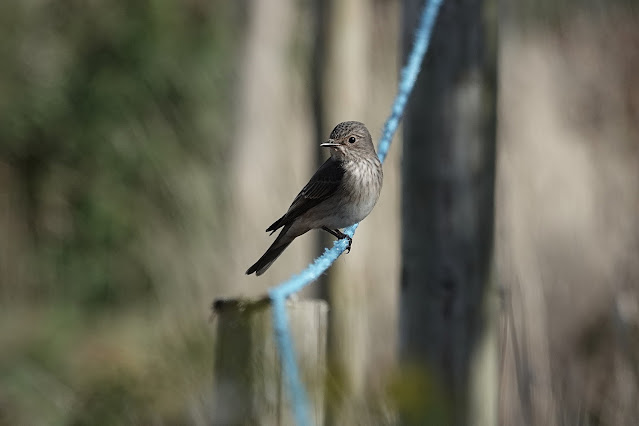I spent most of the day birding in the Laurel forest near Erjos in NW Tenerife.
Between the village and the start of the track that led to Monte del Aqua I saw Canary Islands Chiffchaff, Canary, Blue Chaffinch, Blackbird, Raven and heard a Sardinian Warbler.
There is a track that leads to Monte del Aqua and beyond and runs close to the village and leads down through the forest for perhaps 10kM. The birding was extremely hard as the trees lined both sides of the track for much of the way and did not allow long distance views across the forest. The best viewpoint was in fact at Monte del Aqua.  |
The track leading to Monte del Aqua.
A fairly typical view but the trees were larger further on. |
 |
The Laurel Forest from the track. Most of the forest was on mountainous slopes!
|
On entering the Laurel forested area very few birds were seen or heard. Over the next two hours I saw one Laurel Pigeon fairly close for about a minute. The bird flew in and landed about 25 metres away but partly obscured, so I only got a good view of it's head and the front half of the bird. Fortunately it's red eye helped clinch the identification (Bolle's Pigeon has a yellow eye). I was hoping to photograph the bird but it flew before I could get my camera ready. Later I had two other Pigeons fly into the forest fairly close by (ID by their noisy flight) but neither stayed and were unseen. I was hoping to find Bolle's Pigeon, which would have been a life tick but it was not to be.
As I got to a lower altitude the forest changed and a few other bird species were seen. These included Canary, Tenerife Goldcrest and Robin. There were Canary Islands Chiffchaffs along the whole trail. Photography was very difficult and I failed to get any Chiffchaff photos as the birds were usually fairly high in the vegetation and moving around a lot. I did manage to get a few record shots of a Tenerife Goldcrest which are shown below.
 |
| Tenerife Goldcrest Regulus regulus teneriffae - This is a sub-species of the Goldcrest Regulus regulus and is endemic to Tenerife and the nearby island of La Gomera. |
 |
Robin - Taken in the dark understory of the Laurel Forest.
A species I get in my garden at home! |
Towards the lower parts of the trail there were exposed rocks on the steep slopes. These attracted some fast moving Lizards.
 |
| Lizard Species - These were very common. |
After I left the forest, I returned to Playa de las Americas by bus. From the bus station to the hotel was a 10 minute walk and along a fairly quiet road I cam across a Hoopoe feeding on the grass verge. I gradually moved closer and the bird ignored my presence and I managed some nice photos and a video.
 |
| Hoopoe - As I first saw it. The road on the right did have some vehicles pass by but they did not disturb it. I approached to where the metal drains were in this photo. |
 |
| The Hoopoe stayed in the shady area. Presumably that is where the food was. |
 |
| At times the Hoopoe was probing deep into the grass. |
 |
A stunning bird!
A short video clip of the Hoopoe follows.
|







































































